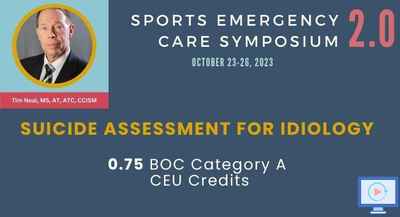Course Info (BOC Domains of Athletic Training; Presentation Description; Learning Objectives; Clinical Practice Gap Statement; Clinical Bottom Line; Summary Conclusions)
BOC Domains of Athletic Training:
- Domain I - Injury and Illness Prevention and Wellness Promotion
- Domain II - Examination, Assessment and Diagnosis
- Domain Ill - Critical Incident Management
-
Domain V - Healthcare Administration and Professional Responsibility
Presentation Description:
This presentation addresses a critical aspect of sports emergency care – suicide assessment for ideology among athletes. It provides a comprehensive understanding of the factors that contribute to suicide risk in athletes, equipping athletic trainers and students with the knowledge and skills necessary to identify athletes at risk. The session emphasizes effective communication techniques to approach the sensitive topic of suicide and guides attendees on appropriate referral pathways and available resources for at-risk athletes. Ultimately, the presentation focuses on empowering the audience to play a pivotal role in suicide prevention within athletic settings.
Learning Objectives:
- Discuss the prevalence of suicide
- Discuss the importance of identifying suicide idiology
- Review the Columbia Suicide Severity Rating Scale
- Discuss patient privacy and confidentiality related to mental health emergencies
- Discuss immediate and follow-up steps for suicide-focused emergencies in athletic settings
Clinical Practice Gap Statement:
Within the scope of sports emergency care, the topic of suicide assessment for ideology is often sidelined, leaving a dangerous gap in the capabilities of athletic trainers and students. This deficiency in education and training means that they are not adequately prepared to identify and intervene in cases of suicidal ideation among athletes, creating a critical risk to athlete well-being. An educational void exists concerning both the recognition of signs and the development of intervention strategies. The need for focused education and concrete guidelines in this area cannot be overstated.
Clinical Bottom Line Statement:
Being prepared to identify suicide risks among athletes is non-negotiable for athletic trainers and students. Not only should they be proficient in recognizing the warning signs and risk factors, but they also need to be adept in sensitively communicating about this delicate issue. Furthermore, they must be knowledgeable about the appropriate referral resources and pathways to facilitate timely and effective intervention. This multi-faceted approach is fundamental to preserving both the mental and physical health of athletes.
Summary Conclusion Statements:
- Mastery of the key contributing factors to athlete suicide risk is foundational for effective sports emergency care.
- Skillful identification of signs and symptoms associated with suicidal ideation is indispensable for timely intervention.
- Proficiency in tactful communication techniques is central to addressing the subject of suicide with athletes.
- Acquiring a robust understanding of the available referral pathways and resources is essential for providing comprehensive care to at-risk athletes.
- Athletic trainers and students are instrumental in implementing proactive strategies for suicide prevention, solidifying their role as protectors of athlete mental health.


